Airdrie and Coatbridge Tramways
History
Although there were a number of abortive schemes in the early 1870s to build horse tramways in and around Airdrie and Coatbridge, it would be nearly 30 years before a tramway was finally constructed.
In September 1897, a committee representing the two local councils — the Burghs of Airdrie and Coatbridge — met to consider two proposals for electric tramways. The first of these came from the Electric Construction Company, which had in an earlier incarnation, been an important pioneer of electric tramway development in the United Kingdom, most notably on the South Staffordshire Tramways in the Black Country. The EEC was, however, in the process of divesting its tramway holdings, having just transferred its interests in the South Staffordshire Tramways Company to the British Electric Traction Company. In the late 1890s, the latter was aggressively purchasing horse and steam-operated tramways across the British Isles with the intention of converting them to electric traction, as well as promoting schemes for completely new electric tramways. At its zenith, the BETCo, would either own, part-own or lease almost fifty tramway concerns across the British Isles.
The ECCo appears to have handed over its Airdrie and Coatbridge tramway scheme to the BETCo in early October 1897, as it withdrew its proposals on the 11th October, only for the BETCo to appear on the scene the following month.
The second scheme came from the New General Traction Company, which had just opened Coventry's new electric tramway, and would go on to build and operate both Norwich Electric Tramways, and Douglas Southern Electric Tramways.
On the 1st February 1898, the council committee agreed to support the BETCo scheme, though precisely what happened next is unclear, as there was a hiatus of nearly two years before further progress was made, and not by the BETCo. On the 30th July 1900, the Scottish House-to-House Electricity Supply Company obtained powers — under the Airdrie and Coatbridge Tramways Act, 1900 — to construct electric tramways within the Burgh of Airdrie. The act also incorporated a company — the Airdrie and Coatbridge Tramways Company — to build and operate the tramway. The original bill had included lines in Coatbridge, but authorisation for these was not forthcoming, leaving the SHtoHESCo, whose precise relationship with the NGTCo is unclear, with powers for a tramway that was probably not commercially viable.
The BETCo appears to have quickly stepped in, acquiring the A&CTCo (and its powers), then applying for a provisional order to build lines in Coatbridge (on the 15th April 1901). These powers were granted on the 9th August 1901 under the Tramways Orders Confirmation No 4 Act, 1901.
Although construction commenced in Coatbridge on the 23rd February 1902, progress was painfully slow, in part due to the need to lower the roadway under several railway overbridges, though it may well have had more to do with the BETCo (and its expertise) being heavily committed elsewhere. As a result, the company was forced to seek an extension to the time allowed for construction, this being granted on the 14th August 1903 under the Airdrie and Coatbridge Tramways Order Confirmation Act, 1903. The act also combined the two previous orders.
The tramway finally opened on the 8th February 1904, just one day before the time allowed for construction of one of the major sections expired. The eastern end of the line was at the junction of Clark Street and Motherwell Street in Airdrie, the western end at the junction of Bank Street and Kirkwood Street in Coatbridge. A short extension westwards to Woodside Street was opened on the 16th August 1905, but only after the company had had to seek yet another extension to the time allowed for construction. This took the 4ft 7¾ins-gauge overhead electric tramway to its final length of 3.63 miles. The line ran westwards from Motherwell Street in Airdrie, along Clark Street to Stirling Cross, continuing westwards along Stirling Street, Alexander Street, Deedes Street and Main Street to Coatbridge, before turning southwestwards along Bank Street to its junction with Woodside Street in Langloan. Although the company held powers for more lines, including an extension eastwards to Clarkston, these were never built, the company even deciding to forfeit £1000 to Airdrie Town Council (on the 31st January 1907) rather than build the latter. The tramcar fleet comprised just 15 vehicles.
At the western end of the system, the gap to Glasgow Corporation's system was shortened to circa 4 miles on the 3rd March 1906, when the latter extended its system to Ballieston. Although there was much talk of connecting the two tramways, and this did in fact eventually happen (in 1923), this was not during company days.
The system was well used, and was to lead a relatively uneventful life, the only change of note being its transfer to the Scottish General Transport Company on the 24th September 1913, a company which was expressly set up by the BETCo to manage its tramway and embryonic omnibus undertakings in Scotland, namely, the A&CT, Rothesay Tramways, and Greenock and Port Glasgow Tramways. From this moment on, the A&CTCo's experimental omnibus services, which it had first introduced in November 1911 using vehicles borrowed from the G&PGTCo, were handed over to the SGTCo, which initially used yet another BETCo subsidiary — the British Automobile Traction Company — to manage them.
Following the exigencies of the Great War, the A&CTCo applied for powers to increase the tram fares, which, despite opposition from the two councils, were granted on the 4th August 1920 under the Airdrie and Coatbridge Tramways Order Confirmation Act, 1920. Behind the scenes, however, major changes were in train, as the councils, when notified of the company's intentions in late 1919, had decided to ask the A&CTCo whether it would be prepared to sell them the undertaking. The enquiry was positively received, and following an independent report from the General Manager of Glasgow Corporation Tramways (on the 23rd April 1920), a price and terms were formally agreed (on the 7th May 1920).
The purchase date was set to the 30th September 1920, with the company agreeing to continue operation until such time as the councils could make other arrangements. The two councils quickly set up a Tramways Trust made up of members from each, which was charged with overseeing the transition, and more importantly, obtaining powers to purchase and operate the tramway. The resulting provisional order was confirmed on the 19th August 1921, under the Airdrie and Coatbridge Tramways Trust Order Confirmation Act, 1921.
Meanwhile, Glasgow Corporation had taken the decision to extend its Ballieston line to Coatbridge, where it would of course meet the tracks of the councils' tramway. In October 1921, the Tramways Trust decided to approach Glasgow Corporation, to see whether it would be interested in taking over the tramway and operating it as part of the larger GCT system, a suggestion to which it was positively disposed.
Following negotiations, the tramway was formally transferred to Glasgow's ownership on the 19th December 1921, though it did not take over operation until the 1st January 1922. At the same time, the GCT also pushed forward its plans for the Ballieston to Langloan extension, the new section opening on the 28th December 1923.
The last tram service over the old A&CTCo system — operated by the GCT — ran in the early hours of Sunday morning, the 4th November 1956.
Uniforms
Early photographs show Airdrie and Coatbridge Tramways staff wearing the familiar and largely regulation BETCo uniform. Although uniform jackets varied somewhat between BETCo systems, as well as across the decades, the cap badges, collar designations and buttons invariably followed a standard pattern.
The early jackets were double breasted with five pairs of buttons (bearing the standard BETCo 'Magnet and Wheel' device — see link) and lapels; the collars carried embroidered, block-capital system initials ('A & C T') on both sides. The tensioned-crown peaked caps bore the standard brass BETCo 'Magnet and Wheel' device badge, along with an employee number in individual brass numerals, which was positioned below.
At some point, possibly in 1909, a change was made to double-breasted, lancer-style tunics; these bore five pairs of buttons (narrowing from top to bottom) and stand-up collars. It would appear that the collars initially carried 'A E T' on the bearer's right-hand side and an employee number on the left (all in brass), as adverse comments were made in the local press concerning this. The initials presumably stood for Airdrie Electric Tramways. However, later photographs show the right-hand collars bearing 'A & C T', so the complaints were evidently heeded.
Tramcar crews were also provided with double-breasted greatcoats with five pairs of buttons and high fold-over collars; no insignia whatsoever appears to have adorned these garments.
Inspectors wore typical 'tramway inspector' apparel, comprising single-breasted jackets with hidden buttons (or more likely hook and eye fasteners) and stand-up collars; the jackets were edged in a finer material than the main body, with the collars bearing 'Inspector' in embroidered script lettering. The tensioned-crown peaked caps also bore the grade in embroidered script lettering, but on a hat band; this was initially worn with the standard BETCo cap badge (above), though later without.
Like most systems across Britain, Airdrie and Coatbridge Tramways employed women during the Great War to replace male staff lost to the armed services, initially as conductresses, of which there were seven by September 1915, and from the middle of 1917 as motorwomen too. Photographs depicting these ladies are yet to come to light, so details of the uniforms that they were undoubtedly provided with are unknown.
Further reading
For a history of the system, see: 'Lanarkshire's Trams' by A W Brotchie (Ed); N B Traction (1993).
Images
Motormen and conductors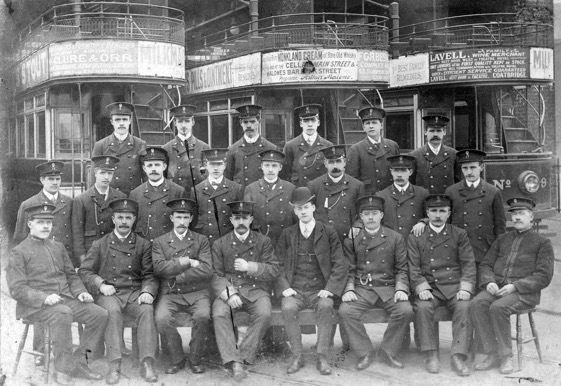
A staff photograph taken at the depot at Main Street — photo undated, but judging by the condition of the tramcars, probably taken shortly after opening in 1904. Author's Collection.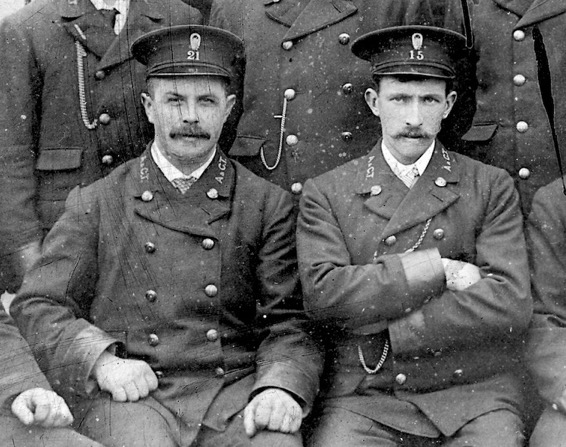
An enlargement of the above photograph showing two of the tramcar staff, Employees 21 and 15. The caps bear the standard BETCo 'Magnet & Wheel' cap badge, along with an employee number, whilst the collars bear 'A & C T' in embroidered block capitals.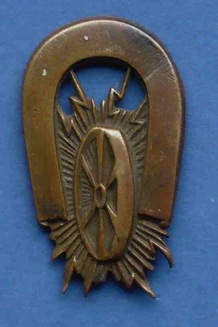
Standard British Electric Traction Company ‘Magnet & Wheel’ cap badge of the type worn by Airdrie and Coatbridge Tramways staff — brass. Author's Collection.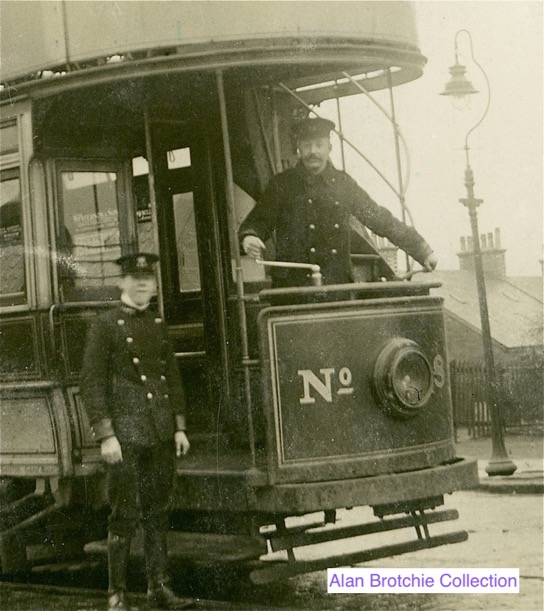
Two A&CT employees, a motorman (on the platform) and an individual of uncertain grade (in gaiters), with Tramcar No 8 at the Langloan terminus in Coatbridge — photo undated, but probably taken just prior to the Great War. Although slightly blurred, the man in gaiters is clearly wearing a lancer-style tunic with stand-up collars.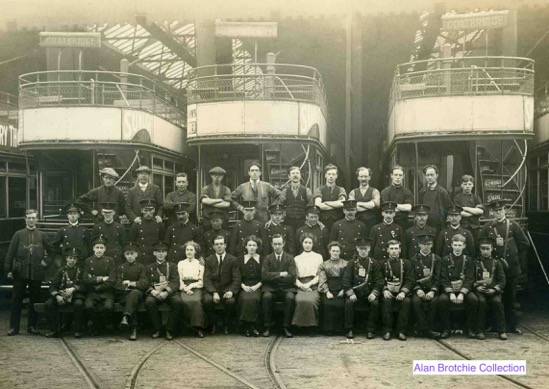
Another staff photograph taken at the depot, but this time from around the time of the Great War.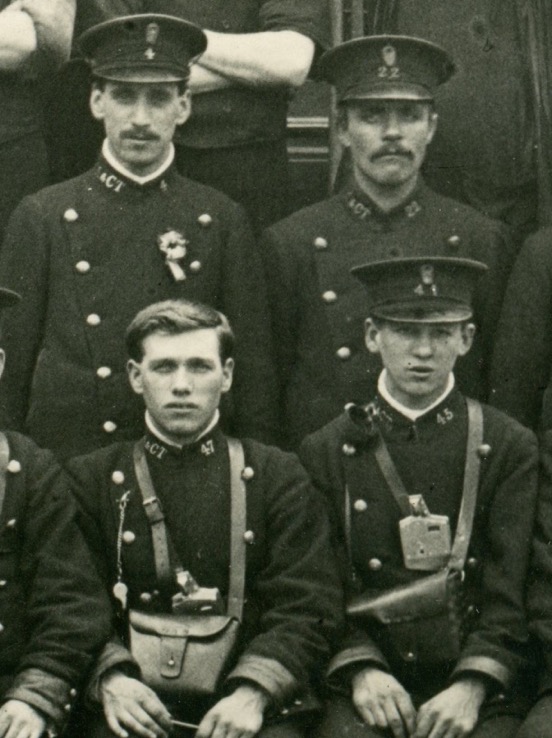
An enlargement of the above photograph showing four of the tramcar staff, probably two motormen (Employee Nos 4 and 22) and two conductors (Employee Nos 47 and 45). All are wearing double-breasted, lancer-style tunics with stand-up collars bearing individual 'A & C T' letters on the right-hand side and an employee number on the left-hand side.
Senior staff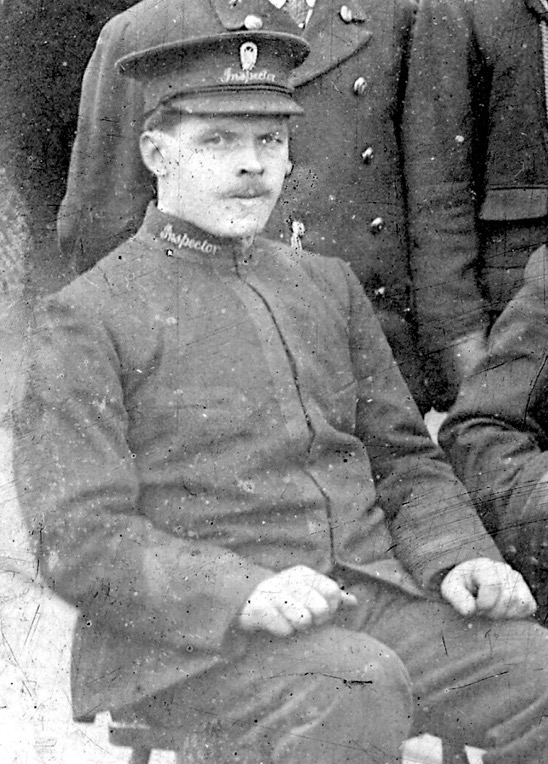
An enlargement of the Edwardian staff photograph above, showing a rather stern looking inspector. Both his cap and his jacket collars bear his grade — 'Inspector' — in embroidered script lettering, the cap additionally carrying the standard BETCo 'Magnet & Wheel' device badge.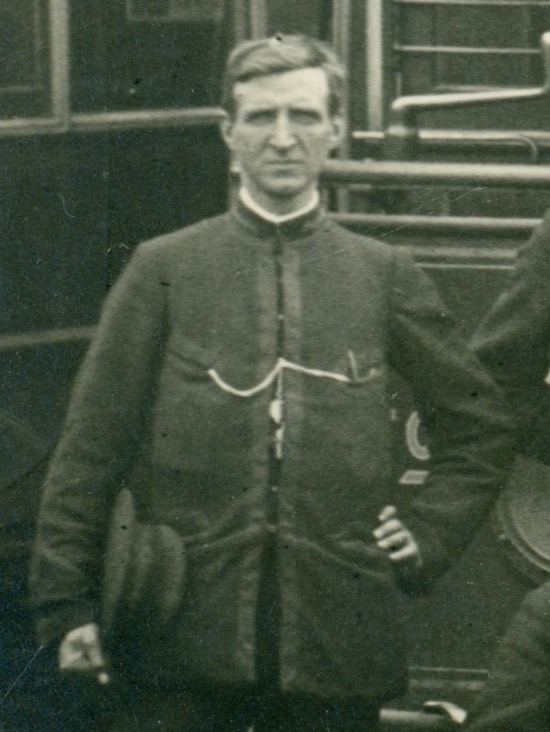
An enlargement of the Great War staff photograph above showing an inspector. The only difference in the uniform from the earlier photo would appear to be the cap, which appears not to carry a BETCo 'Magnet and Wheel' device badge.